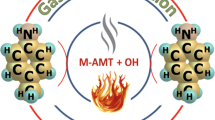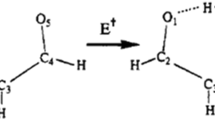Abstract
The tautomeric equilibrium of the title triazole compound was computationally analyzed at the B3LYP/6-311++G(d,p) and MP2/6-311++G(d,p) levels of theory. The solvent effect was considered for three solvents (chloroform, methanol, and water). Two distinct mechanisms were applied: a direct intramolecular transfer using the polarizable continuum model (PCM) and a solvent-assisted mechanism. The calculations indicated that the keto form is more stable in all cases. It was found that the barrier heights for the tautomerization reaction are very high, indicating a relatively disfavored process. Although the barrier heights for solvent-assisted reactions are significantly lower than those for the unassisted tautomerization reaction, implying the importance of the superior catalytic effect of the solvents, monosolvation was not found to be sufficient for the reaction to occur. Finally, the two intermolecular hydrogen-bonding interactions in the crystal structure were investigated in the gas phase; according to the calculated energies and structural parameters, the order of stability is N3–H3···O1 > N1–H1···O1.







Similar content being viewed by others
References
Cucinotta CS, Ruini A, Catellani A, Stirling A (2006) Ab initio molecular dynamics study of the keto-enol tautomerism of acetone in solution. ChemPhysChem 7(6):1229–1234
Brovarets’ OO, Hovorun DM (2013) Prototropic tautomerism and basic molecular principles of hypoxanthine mutagenicity: an exhaustive quantum-chemical analysis. J Biomol Struct Dyn 31(8):913–936
Samijlenko SP, Yurenko YP, Stepanyugin V, Hovorun DM (2011) Tautomeric equilibrium of uracil and thymine in model protein–nucleic acid contacts. Spectroscopic and quantum chemical approach. J Phys Chem B 114(3):1454–1461
Brovarets’ OO, Hovorun DM (2010) How stable are the mutagenic tautomers of DNA bases? Biopolym Cell 26(1):72–76
Brovarets’ OO, Hovorun DM (2010) Stability of mutagenic tautomers of uracil and its halogen derivatives: the results of quantum-mechanical investigation. Biopolym Cell 26(4):295–298
Smith MB, March J (2001) March’s advanced organic chemistry. Wiley, New York
Pitucha M, Karczmarzyk Z, Wysocki W, Kaczor AA, Matosiuk D (2011) Experimental and theoretical investigations on the keto–enol tautomerism of 4-substituted 3-[1-methylpyrrol-2-yl)methyl]-4,5-dihydro-1H-1,2,4-triazol-5-one derivatives. J Mol Struct 994(1–3):313–320
Matosiuk D, Fidecka S, Antkiewicz-Michaluk L, Lipkowski J, Dybala I, Koziol AE (2002) Synthesis and pharmacological activity of new carbonyl derivatives of 1-aryl-2-iminoimidazolidine. Part 2. Synthesis and pharmacological activity of 1,6-diaryl-5,7(1H)dioxo-2,3-dihydroimidazo[1,2-a]-[1,3,5]triazines. Eur J Med Chem 37(9):761–772
Matosiuk D, Fidecka S, Antkiewicz-Michaluk L, Dybala I, Koziol AE (2002) Synthesis and pharmacological activity of new carbonyl derivatives of 1-aryl-2-iminoimidazolidine. Part 3. Synthesis and pharmacological activity of 1-aryl-5,6(1H)dioxo-2,3-dihydroimidazo[1,2-a]imidazoles. Eur J Med Chem 37(10):845–853
Sztanke K, Fidecka S, Kedzierska E, Karczmarzyk Z, Pihlaja K, Matosiuk D (2005) Antinociceptive activity of new imidazolidine carbonyl derivatives. Part 4. Synthesis and pharmacological activity of 8-aryl-3,4-dioxo-2H,8H-6,7-dihydroimidazo[2,1-c][1,2,4]triazines. Eur J Med Chem 40(2):127–134
Temperini C, Cecchi A, Scozzafava A, Supuran CT (2009) Carbonic anhydrase inhibitors. Comparison of chlorthalidone and indapamide X-ray crystal structures in adducts with isozyme II: when three water molecules and the keto–enol tautomerism make the difference. J Med Chem 52(2):322–328
Brovarets’ OO, Hovorun DM (2014) Can tautomerization of the A·T Watson–Crick base pair via double proton transfer provoke point mutations during DNA replication? A comprehensive QM and QTAIM analysis. J Biomol Struct Dyn 32(1):127–154
Brovarets’ OO, Hovorun DM (2014) Why the tautomerization of the G·C Watson–Crick base pair via the DPT does not cause point mutations during DNA replication? QM and QTAIM comprehensive analysis. J Biomol Struct Dyn 32(9):1474–1499
Brovarets’ OO, Hovorun DM (2015) The physicochemical essence of the purine·pyrimidine transition mismatches with Watson–Crick geometry in DNA: A·C* versa A*·C. A QM and QTAIM atomistic understanding. J Biomol Struct Dyn 33(1):28–55. doi:10.1080/07391102.2013.852133
Brovarets’ OO, Hovorun DM (2014) The nature of the transition mismatches with Watson–Crick architecture: the G*·T or G·T* DNA base mispair or both? A QM/QTAIM perspective for the biological problem. J Biomol Struct Dyn 23:1–21. doi:10.1080/07391102.2014.924879
Kosenkov D, Kholod Y, Gorb L, Shishkin O, Hovorun DM, Mons M, Leszczynski J (2009) Ab initio kinetic simulation of gas-phase experiments: tautomerization of cytosine and guanine. J Phys Chem B 113(17):6140–6150
Furmanchuk A, Isayev O, Shishkin OV, Hovorun DM, Leszczynski J (2011) Novel view on the mechanism of water-assisted proton transfer in the DNA bases: bulk water hydration. Phys Chem Chem Phys 13(10):4311–4317
Jeffrey GA, Saenger W (1991) Hydrogen bonding in biological structures. Springer, Berlin
Jeffrey GA (1997) An introduction to hydrogen bonding. Oxford University Press, New York
Desiraju GR, Steiner T (1999) The weak hydrogen bond in structural chemistry and biology. Oxford University Press, Oxford
Yurenko YP, Zhurakivsky RO, Samijlenko SP, Ghomi M, Hovorun DM (2007) The whole of intramolecular H-bonding in the isolated DNA nucleoside thymidine. AIM electron density topological study. Chem Phys Lett 447(1–3):140–146
Sahu PK, Chaudhari A, Lee S-L (2004) Theoretical investigation for the hydrogen bond interaction in THF–water complex. Chem Phys Letters 386(4–6):351–355
Ponomareva AG, Yurenkoa YP, Zhurakivsky RO, van Mourik T, Hovorun DM (2012) Complete conformational space of the potential HIV-1 reverse transcriptase inhibitors d4U and d4C. A quantum chemical study. Phys Chem Chem Phys 14(19):6787–6795
Ponomareva AG, Yurenkoa YP, Zhurakivsky RO, van Mourik T, Hovorun DM (2012) Structural and energetic properties of the potential HIV-1 reverse transcriptase inhibitors d4A and d4G: a comprehensive theoretical investigation. J Biomol Struct Dyn 32(5):730–740
Unangst PC, Shrum GP, Connor DT, Dyer RD, Schrier DJ (1992) Novel 1,2,4-oxadiazoles and 1,2,4-thiadiazoles as dual 5-lipoxygenase and cyclooxygenase inhibitors. J Med Chem 35(20):3691–3698
Mullican MD, Wilson MW, Connor DT, Kostlan CR, Schrier DJ, Dyer RD (1993) Design of 5-(3,5-di-tert-butyl-4-hydroxyphenyl)-1,3,4-thiadiazoles, -1,3,4-oxadiazoles, and -1,2,4-triazoles as orally-active, nonulcerogenic antiinflammatory agents. J Med Chem 36(8):1090–1099
Jones DH, Slack R, Squires S, Wooldridge KRH (1965) Antiviral chemotherapy. I. The activity of pyridine and qinoline derivatives against neurovaccinia in mice. J Med Chem 8(5):676–680
Sughen JK, Yoloye T (1978) Medicinal applications of indole derivatives. Pharm Acta Helv 53(3–4):65–92
Shams El-Dine SA, Hazzaa AAB (1974) Synthesis of compounds with potential fungicidal activity. Pharmazie 29:761–763
Stillings MR, Welbourn AP, Walter DS (1986) Substituted 1,3,4-thiadiazoles with anticonvulsant activity. 2. Aminoalkyl derivatives. J Med Chem 29(11):2280–2284
Sztanke K, Tuzimski T, Rzymowska J, Pasternak K, Kandefer-Szerszeń M (2008) Synthesis, determination of the lipophilicity, anticancer and antimicrobial properties of some fused 1,2,4-triazole derivatives. Eur J Med Chem 43(2):404–419
Ilango K, Valentina P (2010) Synthesis and biological activities of novel 1,2,4-triazolo-[3,4-b]-1,3,4-thiadiazoles. Der Pharm Chem 2(2):16–22
Demirbas N, Ugurluoglu D, Demirbas A (2002) Synthesis of 3-alkyl(aryl)-4-alkylidenamino-4,5-dihydro-1H-1,2,4-triazol-5-ones and 3-alkyl-4-alkylamino-4,5-dihydro-1H-1,2,4-triazol-5-ones as antitumor agents. Bioorg Med Chem 10(12):3717–3723
Kane JM, Dudley MW, Sorensen SM, Miller FP (1988) 2,4-Dihydro-3H-1,2,4-triazole-3-thiones as potential antidepressant agents. J Med Chem 31(6):1253–1258
Vreugdenhil W, Haasnoot JG, Reedijk J, Spek AL (1987) Ferromagnetic and antiferromagnetic spin coupling in Ni4O4 cubane-type clusters with 4-amino-3,5-bis(hydroxymethyl)-1,2,4-triazole as a ligand. The X-ray structure of a new dumbbell-like double cubane cluster. Inorg Chim Acta 129(2):205–216
Van Albada GA, De Graaff RAG, Haasnoot JG, Reedijk J (1984) Synthesis, spectroscopic characterization, and magnetic properties of unusual 3,5-dialkyl-1,2,4-triazole compounds containing N-bridging isothiocyanato ligands. X-ray structure of trinuclear bis[(μ-thiocyanato-N)bis(μ-3,5-diethyl-1,2,4-triazole-N 1,N 2)bis(thiocyanato-N)(3,5-diethyl-1,2,4-triazole-N 1)nickel(II)-N,N 1,N 1′]nickel(II) dihydrate. I. Inorg Chem 23(10):1404–1408
Vos G, le Febre RA, de Graaff RAG, Haasnoot JG, Reedijk J (1983) Unique high-spin-low-spin transition of the central ion in a linear, trinuclear iron(II) triazole compound. J Am Chem Soc 105(6):1682–1683
Kahn O, Martinez CJ (1998) Spin-transition polymers: from molecular materials toward memory devices. Science 279(5347):44–48
Peng C, Ayala PY, Schlegel HB, Frisch MJ (1996) Using redundant internal coordinates to optimize equilibrium geometries and transition states. J Comput Chem 17(1):49–56
Dennington R II, Keith T, Millam J (2007) GaussView, version 4.1.2. Semichem Inc., Shawnee Mission
Frisch MJ, Trucks GW, Schlegel HB, Scuseria GE, Robb MA, Cheeseman JR, Montgomery JA Jr, Vreven T, Kudin KN, Burant JC, Millam JM, Iyengar SS, Tomasi J, Barone V, Mennucci B, Cossi M, Scalmani G, Rega N, Petersson GA, Nakatsuji H, Hada M, Ehara M, Toyota K, Fukuda R, Hasegawa J, Ishida M, Nakajima T, Honda Y, Kitao O, Nakai H, Klene M, Li X, Knox JE, Hratchian HP, Cross JB, Bakken V, Adamo C, Jaramillo J, Gomperts R, Stratmann RE, Yazyev O, Austin AJ, Cammi R, Pomelli C, Ochterski JW, Ayala PY, Morokuma K, Voth GA, Salvador P, Dannenberg JJ, Zakrzewski VG, Dapprich S, Daniels AD, Strain MC, Farkas O, Malick DK, Rabuck AD, Raghavachari K, Foresman JB, Ortiz JV, Cui Q, Baboul AG, Clifford S, Cioslowski J, Stefanov BB, Liu G, Liashenko A, Piskorz P, Komaromi I, Martin RL, Fox DJ, Keith T, Al-Laham MA, Peng CY, Nanayakkara A, Challacombe M, Gill PMW, Johnson B, Chen W, Wong MW, Gonzalez C, Pople JA (2004) Gaussian 03. Revision E.01. Gaussian Inc., Wallingford
Becke AD (1993) Density-functional thermochemistry. III. The role of exact exchange. J Chem Phys 98(7):5648–5652
Lee C, Yang W, Parr RG (1988) Development of the Colle–Salvetti correlation-energy formula into a functional of the electron density. Phys Rev B 37(2):785–789
Krishnan R, Binkley JS, Seeger R, Pople JA (1980) Self‐consistent molecular orbital methods. XX. A basis set for correlated wave functions. J Chem Phys 72(1):650–654
Frisch MJ, Pople JA, Binkley JS (1984) Self-consistent molecular orbital methods 25. Supplementary functions for Gaussian basis sets. J Chem Phys 80(7):3265–3269
Frisch MJ, Head-Gordon M, Pople JA (1990) Semi-direct algorithms for the MP2 energy and gradient. Chem Phys Lett 166(3):281–289
Gonzalez C, Schlegel HB (1989) An improved algorithm for reaction path following. J Chem Phys 90(4):2154–2161
Gonzalez C, Schlegel HB (1990) Reaction path following in mass-weighted internal coordinates. J Phys Chem 94(14):5523–5527
Hobza P, Zahradnik R (1988) Intermolecular interactions between medium-sized systems. Nonempirical and empirical calculations of interaction energies: successes and failures. Chem Rev 88(6):871–897
van Duijneveldt FB, van Duijneveldt-van de Rijdt JGCM, van Lenthe JH (1994) State of the art in counterpoise theory. Chem Rev 94(7):1873–1885
Boys SF, Bernardi F (1970) The calculation of small molecular interactions by the differences of separate total energies. Some procedures with reduced errors. Mol Phys 19(4):553–566
Miertuš S, Scrocco E, Tomasi J (1981) Electrostatic interaction of a solute with a continuum. A direct utilization of ab initio molecular potentials for the prevision of solvent effects. Chem Phys 55(1):117–129
Barone V, Cossi M (1998) Quantum calculation of molecular energies and energy gradients in solution by a conductor solvent model. J Phys Chem A 102(11):1995–2001
Cossi M, Rega N, Scalmani G, Barone V (2003) Energies, structures and electronic properties of molecules in solution with the C-PCM solvation model. J Comput Chem 24(6):669–681
Tomasi J, Mennucci B, Cammi R (2005) Quantum mechanical continuum solvation models. Chem Rev 105(8):2999–3093
Moore WJ (1974) In: Physical chemistry. Longman, London, pp 282–299
Atkins PW (1994) In: Physical chemistry. Oxford University Press, Oxford, pp 147–170
Özdemir N, Dinçer M, Kahveci B, Ağar E, Şaşmaz S (2003) 4-(m-Chlorobenzylamino)-3-phenyl-4,5-dihydro-1H-1,2,4-triazol-5-one. Acta Crystallogr E59(8):o1223–o1225
Nikolaienko TY, Bulavin LA, Hovorun DM (2011) How flexible are DNA constituents? The quantum-mechanical study. J Biomol Struct Dyn 29(3):563–575
Bernstein J, Davis RE, Shimoni L, Chang NL (1995) Patterns in hydrogen bonding: functionality and graph set analysis in crystals. Angew Chem Int Ed Engl 34:1555–1573
Iogansen AV (1999) Direct proportionality of the hydrogen bonding energy and the intensification of the stretching ν(XH) vibration in infrared spectra. Spectrochim Acta A 55(7–8):1585–1612
Acknowledgments
We would like to thank the reviewers for their helpful comments and suggestions to improve the manuscript.
Author information
Authors and Affiliations
Corresponding author
Rights and permissions
About this article
Cite this article
Arslan, N.B., Özdemir, N. Direct and solvent-assisted keto–enol tautomerism and hydrogen-bonding interactions in 4-(m-chlorobenzylamino)-3-phenyl-4,5-dihydro-1H-1,2,4-triazol-5-one: a quantum-chemical study. J Mol Model 21, 19 (2015). https://doi.org/10.1007/s00894-015-2574-8
Received:
Accepted:
Published:
DOI: https://doi.org/10.1007/s00894-015-2574-8




